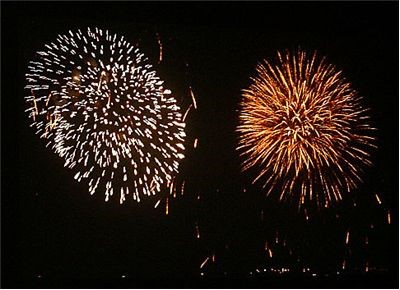Info
Current Location: Home > Info>Firework Invention
Who Invented Fireworks?
Posted on 2018-02-01

Fireworks are a type of explosive pyrotechnic devices which are used during festivals, celebrations and religious events. They are designed to burn in many colors and to produce noise, light, smoke and floating materials like confetti. Fireworks are generally classified as to where they perform, either on the ground or as aerial firework. If they are aerial firework, they may have their own propulsion, and are called skyrockets, or they can be shot into the air by a mortar, called aerial shells.
Fireworks appeared for the first time in 10th century China. Before fireworks, Chinese used bamboo thrown in fire, whose air pockets would explode when heated, to ward off evil spirits. After invention of the gunpowder in the early 10th century, first fireworks appeared. The skill of firework-making developed into an independent profession and people that made fireworks, pyrotechnicians, were respected for their knowledge.
Fireworks could be freely bought from market vendors since the Song Dynasty (960–1279) and there are documents that tell about large fireworks displays that were held since that time. Fireworks entertained Emperor Huizong of Song (r. 1100–1125) and his court, and Empress Dowager Gong Sheng in 1264. Spring Festival (Chinese New Year) and the Mid-Autumn Festival are still times when the fireworks are used.
In 13th century, gunpowder comes to Arabia and is used for rockets, fireworks, and other incendiaries. Arabs referred to fireworks as Chinese flowers. Fireworks came to Europe in 17th century with development of chinoiserie - a fashion which reflected Chinese artistic influences. In 1758, the Jesuit missionary Pierre Nicolas le Chéron d'Incarville, who at the time lived in Beijing, wrote to the Paris Academy of Science on how to make many types of Chinese fireworks. These works were published and later translated on other languages which popularized fireworks in Europe even more. Fireworks became a way to commemorate military victories and later a way to magnify public celebrations and religious ceremonies. The first European fireworks experts were called firemasters while their assistants were called “green men” because they wore caps of leaves to protect their heads from sparks. They also worked as jesters and entertained the crowd with jokes while they were preparing the show. During Renaissance, pyrotechnic schools began training fireworks artists across Europe and firework art started spreading. Italy became famous for its elaborate and colorful firework displays. Italians were also famous for incorporating trace amounts of metals and other additives in the 1830s. These additives created bright, multicolored sparks which were more beautiful than fireworks used until then and their experimentation was basis for today’s colorful displays.
The earliest settlers brought fireworks to America, and they have been used to celebrate Independence Day, 4th of July, since the earliest days of the United States. In time fireworks became bigger, more powerful, and more dangerous and between 1900 and 1930 more than 4,000 people died from the misuse of fireworks. Because of that many laws and regulations were introduced and display fireworks are restricted by law for use by professionals that have licenses.